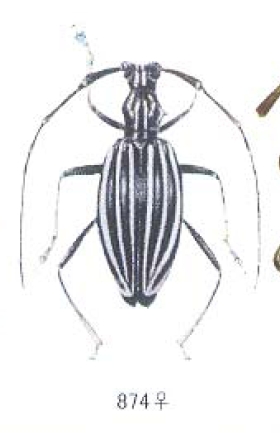| T O P I C R E V I E W |
| Francesco |
Posted - 06/04/2015 : 10:44:22
Many of us have bought the book
HUA L.Z., NARA H., SAMUELSON G. A. & LINGAFELTER S.W, 2009 - Iconography of Chinese Longicorn Beetles (1406 Species) in Color - Sun Yat-sen University Press, Guangzhou, 474 pp. for the identification of Chinese Cerambycids.

Though this book shows a very large amount of pictures of identified species, it includes several mistakes, erroneous identifications and misspellings.
With the purpose of helping the colleagues to a correct identification and the authors in editing the second edition (as suggested in the preface), I open this topic, where the member of the Forum can signalize the errors they will find. |
| 15 L A T E S T R E P L I E S (Newest First) |
| Vitali |
Posted - 07/09/2022 : 13:38:45

43.92 KB
What happened to Eodorcadion egregium? A diet?
Does anyone have an idea what beetle could this be otherwise? |
| cerambyphil |
Posted - 18/11/2021 : 19:35:39

44.99 KB
page 21, fig 237, Aeolesthes chrisothrix thibetana
should be Pseudoaeolesthes rufimembris (Pic, 1923)
|
| Xavier |
Posted - 15/07/2020 : 21:10:06

page 86, fig. 985, Leptomesosa cephalotes Pic
should be Daxata (Laodaxata) lepesmei Breuning, 1961 |
| Francesco |
Posted - 17/06/2020 : 17:35:29

page 123, fig. 420, Pronocera angusta (Kriechbaumer)
evidently, Phymatodes testaceus (Linnaeus) |
| Francesco |
Posted - 17/06/2020 : 17:30:20
 
page 122-123, fig. 1416, Penichroa timida (Menétries)
must be Penichroa fasciata (Stephens) |
| Francesco |
Posted - 17/06/2020 : 17:25:31

page 99, fig. 1137, Oberea fuscipennis (Chevrolat)
must be Oberea formosana Pic |
| Francesco |
Posted - 17/06/2020 : 17:21:29

97.95 KB
page 87, fig. 1002, Macrochenus guerini White
must be Macrochenus isabellinus Aurivillius |
| Francesco |
Posted - 17/06/2020 : 17:17:06
Let's go ahead.

page 43, fig. 509, Neocerambyx tawaneum Hayashi
must be Neocerambyx tawanensis Hayashi
The species belongs now to the genus Pseudopachydissus |
| xiaoxiaozhuniu |
Posted - 15/12/2019 : 15:36:11
Emm...... |
| Francesco |
Posted - 14/12/2019 : 21:54:30
quote:
Originally posted by xiaoxiaozhuniu
The right I tend to think of it as Parhoplothrix szetschuanicus (From Guangxi), the color is slightly fading compared with the fresh specimen.

96.65 KB
This species has nothing to do with the description of Parhoplothrix szetschuanicus (Cf. here) |
| xiaoxiaozhuniu |
Posted - 14/12/2019 : 06:02:24
quote:
Originally posted by Francesco

page 105, fig, 1204 Parhoplothrix szetschuanicus Breuning
seems to be Mimothestus annulicornis Pic
About Parhoplothrix szetschuanicus , once I have checked several specimens in the Museum of Sun Yat-sen University. There are distinct differences with Mimothestus annulicornis. The specimen has the sparser and coraser granules on basal elytra, and the antennae are not fringed with dense and long hairs below.
The left is Mimothestus annulicornis (from Yunnan). The right I tend to think of it as Parhoplothrix szetschuanicus(From Guangxi), the color is slightly fading compared with the fresh specimen.

96.65 KB |
| Francesco |
Posted - 16/11/2019 : 16:23:25

page 57, fig. 658, Xylotrechus formosanus Schwarzer
must be Xylotrechus atronotatus (Pic) |
| Francesco |
Posted - 16/11/2019 : 14:41:33

page 56, fig. 647, Xylotrechus atronotatus (Pic)
must be Xylotrechus subscalaris basalis Schwarzer
|
| Francesco |
Posted - 16/11/2019 : 14:33:59

page 70, fig. 807, Blepephaeus ocellatus (Gahan)
must be Blepephaeus fulvus (Pic)
Another inversion of numbers. |
| Xavier |
Posted - 08/05/2017 : 12:08:36

page 70, fig. 806, Blepephaeus fulvus (Pic)
must be Blepephaeus ocellatus (Gahan) |


